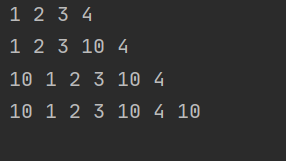数据结构 链表的各种插入
本文共 1261 字,大约阅读时间需要 4 分钟。
提示:文章写完后,目录可以自动生成,如何生成可参考右边的帮助文档
文章目录
前言
链表的任意的位置插入时间复杂度都是O(1),没有增容问题,插入一个就开辟一个空间,这是链表相对于顺序表的优点,那么我们就来看看这个各种插入是怎样插入的。
1.中间位置插入

public static Node MidInsertion(Node head,Node Insert,int index){ Node cur = head; if(index<1||index>Length(head))//插入位置越界了,位置不能是头部 return cur; for (int i=0;i 因为输入了要插入位置的下标,那就得到个位置结束for循环,这时候cur就指向该下标的的节点了,这时候修改要插入的节点的指向就可以了,注意这里修改的循序不能打乱。
2.头部插入
public static Node HeadInsertion(Node head,Node Insert){ Node cur = head; Insert.next=cur; cur=Insert; return cur; } 头部插入这里只需要更改指向就可以了,不用在进行遍历了,使头结点的引用指向要插入的结点,插入的节点的next指向原来的头结点。
3.尾部插入
public static Node LastInsertion(Node head,Node Insert){ Node cur=head; while(cur.next!=null){ cur=cur.next; } cur.next=Insert; return head; } 尾插入需要先走到链表的末尾,然后只要让原来指向null的最后一个节点,指向要插入的节点就可以了。
验证
public static void main(String[] args) { Node head=GreateLink(); print(head); Node Insert=new Node(10); MidInsertion(head,Insert,3); print(head); Node Insert1=new Node(10); head=HeadInsertion(head,Insert1); print(head); Node Insert2=new Node(10); LastInsertion(head,Insert2); print(head); } 
转载地址:http://tsog.baihongyu.com/
你可能感兴趣的文章
nginx负载均衡的5种策略(转载)
查看>>
nginx负载均衡的五种算法
查看>>
Nginx负载均衡(upstream)
查看>>
nginx转发端口时与导致websocket不生效
查看>>
Nginx运维与实战(二)-Https配置
查看>>
Nginx部署_mysql代理_redis代理_phoenix代理_xxljob代理_websocket代理_Nacos代理_内网穿透代理_多系统转发---记录021_大数据工作笔记0181
查看>>
Nginx配置Https证书
查看>>
Nginx配置ssl实现https
查看>>
Nginx配置TCP代理指南
查看>>
Nginx配置——不记录指定文件类型日志
查看>>
nginx配置一、二级域名、多域名对应(api接口、前端网站、后台管理网站)
查看>>
Nginx配置代理解决本地html进行ajax请求接口跨域问题
查看>>
nginx配置全解
查看>>
Nginx配置参数中文说明
查看>>
Nginx配置后台网关映射路径
查看>>
nginx配置域名和ip同时访问、开放多端口
查看>>
Nginx配置多个不同端口服务共用80端口
查看>>
Nginx配置好ssl,但$_SERVER[‘HTTPS‘]取不到值
查看>>
Nginx配置如何一键生成
查看>>
Nginx配置实例-动静分离实例:搭建静态资源服务器
查看>>